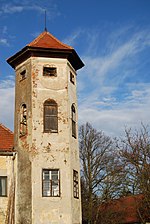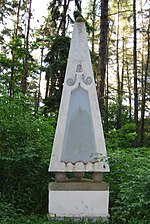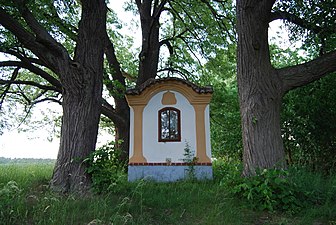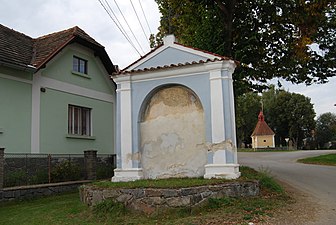Rakovice (Czech Republic)
| Rakovice | ||||
|---|---|---|---|---|
|
||||
| Basic data | ||||
| State : |
|
|||
| Region : | Jihočeský kraj | |||
| District : | Písek | |||
| Area : | 1048 ha | |||
| Geographic location : | 49 ° 28 ' N , 14 ° 3' E | |||
| Height: | 438 m nm | |||
| Residents : | 215 (Jan. 1, 2019) | |||
| Postal code : | 398 04 | |||
| License plate : | C. | |||
| traffic | ||||
| Street: | Čimelice - Mirovice | |||
| Next international airport : | České Budějovice Airport | |||
| structure | ||||
| Status: | local community | |||
| Districts: | 1 | |||
| administration | ||||
| Mayor : | Miroslav Sedláček (as of 2012) | |||
| Address: | Rakovice 119 398 04 Čimelice |
|||
| Municipality number: | 562068 | |||
| Website : | www.rakovice.cz | |||
Rakovice (German Rakowitz ) is a municipality in the Czech Republic . It is located five kilometers north of Mirotice and belongs to the Okres Písek .
geography
Rakovice is located in the valley of the Rakovický brook in the Blatenská pahorkatina. The Jezvinec rises to the north (545 m), the Chlum (532 m) to the south, the Hrad ( Schafberg , 574 m) southwest and the Křemenec (559 m) and the Hora (522 m) to the northwest.
Neighboring places are U Vršeckého, Nad Řištinami and Horní Nerestce in the north, Krsice and Rabuška in the north-east, Čimelice in the east, Smetanova Lhota in the south-east, U Macků and Rakovické Chalupy in the south, Boudy , Lučkovice, Výášice and Chrást in the south-west Kozmovci, Na Krůvku, Svobodka, Ostrov and Na Pile in the west and Pohoří, Minice , Slavkovická Hora, Slavkovice and Kakovice in the northwest.
history
Archaeological finds prove an early settlement of the area. On the Hrad there was since the 5th century BC A Celtic castle complex. The Celtic settlement probably became extinct in the 5th century BC. And in the 9th century the area was repopulated by Slavs.
The royal manor Rakovice was first mentioned in a document in 1045 when it was donated to the Břevnov monastery . There is evidence of a church and a parish in Rakovice since 1356. According to the tax book of the archbishopric Příbram of 1379 and the Příbram land register of 1390, Rakovice was the largest of the 47 villages of the rule and in 1379 consisted of 82 properties. Since one of the estates was significantly larger than the others, it is assumed that Rakovice was an aristocratic estate at that time. The first named owner of the Rakovice feudal estate was Zachar von Rakovice in the second half of the 14th century. Between 1405 and 1491, the Jezovec von Rakovice family can be traced as the owners of the fief and the fortress. The church was destroyed during the Hussite Wars and the Rakovice parish became extinct forever. Since the end of the 15th century, there has been no further information about leanings. During this time Jan the Younger Bejček von Nespečov was mentioned as the owner. In 1574 the brothers Johann, Peter, Hendrych and Alesch Deym Ritter von Střitetz on Čimelitz bought the Rakowitz estate from the court chamber as hereditary property. In 1597 Rakowitz passed to Alesch Deym Ritter von Střitetz on Čimelitz, followed by his son Peter. Its goods were confiscated after the battle of the White Mountain . In 1623 the Protestant was sentenced to lose ownership of Rakovice. The property fell back into the feudal relationship and Deym had to pay one hundredth of the estimated value for the property to the court chamber every year. After the fortress and the court burned down in 1627, Peter Deym von Střitetz waived these annual payments. In 1647 Emperor Ferdinand III dismissed . the Rakowitz estate again from the fief. After Peter Deym's death, his four daughters sold the estate in 1653 to the six-year-old Johann Adalbert Wratislaw von Mitrowitz , whose guardians had a brewery built in Rakowitz. In 1657 Johann Adalbert had Ten Commandments written down for his subjects under the title Stará paměť . He sold the estate in September 1658 to Ladislav Hrobčicky von Hrobčitz , who in 1662 also acquired the town of Mirotitz . Between 1665 and 1669 he had the palace redesigned and between 1681 and 1685 he was the second district chief of the Prachiner district; During this time, Rakowitz was the seat of the district office for the Prachiner district. He was followed by his three daughters and after an inheritance was divided, the Rakowitz estate fell to Johanna Theresia Hrobčicka, married Countess Millesimo, in 1705.
In 1714, the captain of the Prachiner district, Karl Gottlieb Baron von Bissingen on Čimelitz, acquired the Rakowitz estate and initially relocated a seat from Čimelitz to the more comfortable Rakowitz Castle. Von Bissingen built a new castle in Čimelitz between 1728 and 1730 and added the Rakowitz estate to the Čimelitz rule. While Čimelitz Castle served as a manorial residence, the official chancellery and officials' apartments were set up in Rakowitz Castle. There was also a prison and the manorial archive in Rakowitz Castle. Von Bissingen had both castles connected by an avenue of lime trees, and between 1736 and 1741 he brought the Pilsen sculptor Jan Hammer to Čimelitz to decorate it with sculptures. With the re-routing of the Passau Kaiserstraße, which led via Rakowitz and Mirotitz until 1730 , Rakowitz increasingly lost its importance compared to the then much smaller Čimelitz, which was on the new Chaussee. In 1742 Karl Gottfried Graf von Bissingen inherited the rule. He died on January 4, 1771 without male descendants, the subsequent owner was his widow Maria Appollonia, née Countess Wratislaw von Mitrowitz. In 1782 she appointed her brother Prokop Imperial Count Wratislaw von Mitrowitz as heir of Čimelitz. This sold the rule in 1798 to his nephew Joseph Imperial Count Wratislaw von Mitrowitz. In 1834 his widow Gabriele, née Countess Desfours, inherited the rule and handed it over to the administration of her son-in-law Karl II. Prince of Schwarzenberg on Worlik . In 1837 Rakowitz consisted of 72 houses with 490 inhabitants, including three Israelite families. There was an old castle with the director's apartment in the village. The layers Pila ( Na Pile ) and Chlum ( U Macků ), each consisting of a rustic chalet, as well as the Hegerhaus Chlum lay apart . The parish was Čimelitz. Until the middle of the 19th century, Rakowitz formed the official village of the Čimelitz dominion and was subject to the allodial rule Čimelitz including Straschowitz and Slawkowitz.
After the abolition of patrimonial Rakovice / Rakowitz formed from 1850 a district of the municipality Čimelice in the district administration Písek and the judicial district Mirovice. On February 21 of the same year Gabriele Wratislaw von Mitrowitz's sister Josefina Marie bequeathed the Čimelitz estates to her son Karl III. Prince of Schwarzenberg. On April 24, 1874, Rakovice and Rakovické Chalupy broke away from Čimelice and formed the municipality of Rakovice. The manorial archive, including the cadastral map archive, was lost in 1876 when the estate manager sold it as waste paper to a Viennese dealer. The volunteer fire brigade was founded in 1900. Even after the land reform of 1924, the Rakovice farm remained under the administration of the Schwarzenberg princes as one of the smaller Schwarzenberg farms. In 1926 the electrification of the village began. On the night of May 11-12, 1945, negotiations between the Red Army and the US Army on the surrender of the Wehrmacht and the course of the demarcation line in West Bohemia between the Soviet General Sergei Serjogin, the US Lieutenant Allison and General von Pückler completed; von Pückler then shot himself in house number 99 in Rakovice. The Rakovice farm was nationalized in 1948 and then divided among three owners. 1964 the abolition of the municipality took place, whereby Rakovice after Čimelice and Rakovické Chalupy after Mirotice were incorporated. Rakovice broke away from Čimelice on November 24, 1990 and formed its own municipality. Rakovice has had a coat of arms and a banner since 2009.
Community structure
No districts are shown for the municipality of Rakovice. The layers Na Pile ( Pila ) and U Macků ( Chlum ) belong to Rakovice .
Attractions
- Rakovice Castle, a two-wing Renaissance building with a hexagonal turret, was built at the end of the 16th century for the knight Deym von Střitetz instead of an old fortress. It received its present form between 1665 and 1669 under Ladislav Hrobčicky von Hrobčitz. In the 18th century, the chateau was connected to the neighboring Čimelice chateau by an avenue of lime trees with seven pairs of sculptures from the workshop of Jan Karel Hammer, all of which are now in Čimelice. In 1948 it was nationalized. After that the castle served u. a. as a kindergarten and residential building. The castle has been owned by Karel Schwarzenberg since 1993 , who rented the run-down castle to the Berkat refugee aid organization for 50 years in 2007 .
- Chapel of St. Rupert on the village square, it was built 1791–1792 and was originally dedicated to St. Consecrated to John of Nepomuk. The cost of the painting was higher than that of the saint. The chapel was re-consecrated in 1972 to St. Rupert, the reason for this was an incorrect information from the description of the monuments of the Písek district published in 1910 . The chapel is one of the cultural monuments of the Okres Písek.
- Huleš Chapel , a niche chapel on the road to Pohoří. It is one of the cultural monuments of the Okres Písek.
- Niche chapel of St. Sebastian, on the outskirts towards Čimelice
- Niche chapel of St. Anna, at the lower part of the village square towards Boudy. It was built in 1763 and was surrounded by an ornamental garden in 1764. The chapel is one of the cultural monuments of the Okres Písek.
- Memorial to the fallen of World War I from the village square.
- Remains of a Celtic fortress on the Hrad, stone walls are preserved
- Obelisk of St. Gunther in the Chlum forest south of the village, the three-sided pyramid-shaped monument 6 m high stands on three spheres. In the niches there were original figures of St. Wenzel, Ludmilla and Gunther. According to tradition, the memorial was erected on the grave of French soldiers executed for mutiny; according to other sources, a skirmish with French troops took place at the site during the Austro-French War between 1741 and 1743. Various legends have grown up around the obelisk, including the murder of three French princesses and the murder of the three daughters of the French Marshal Broglia. The obelisk is one of the cultural monuments of the Okres Písek.
- Schüttboden, granary south of the village on the road to Mirotice, it is one of the cultural monuments of the Okres Písek.
- Attractions
Sons and daughters of the church
- Josef Huleš (1813–1887), Lord Mayor of Prague
Web links
Individual evidence
- ↑ Český statistický úřad - The population of the Czech municipalities as of January 1, 2019 (PDF; 0.8 MiB)
- ↑ Stará paměť
- ↑ Johann Gottfried Sommer : The Kingdom of Böhmen, Vol. 8 Prachiner Kreis , 1840, pp. 37-38
- ^ Johann Gottfried Sommer : The Kingdom of Böhmen, Vol. 8 Prachiner Kreis , 1840, p. 41







